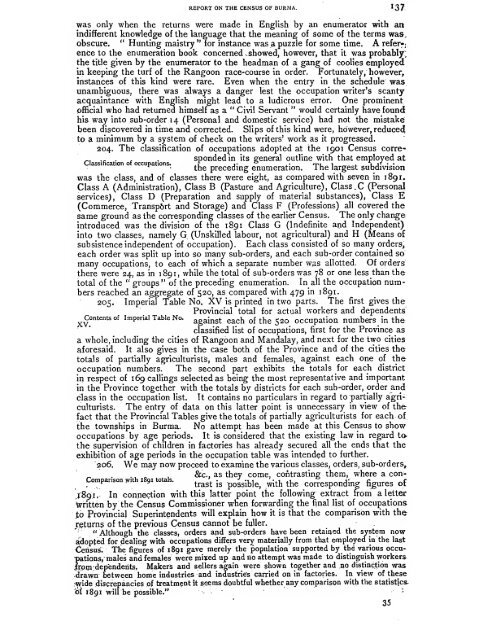Burma: Census of India 1901 Vol. I - Khamkoo
Burma: Census of India 1901 Vol. I - Khamkoo
Burma: Census of India 1901 Vol. I - Khamkoo
Create successful ePaper yourself
Turn your PDF publications into a flip-book with our unique Google optimized e-Paper software.
'<br />
REPORT ON THE CENSUS OF BURMA. 137<br />
was only when the returns were made in English by an enumerator with an<br />
indifferent knowledge <strong>of</strong> the language that the meaning <strong>of</strong> some <strong>of</strong> the terms was,<br />
obscure. " Hunting maistry " for instance was a puzzle for some time. A refer*,<br />
ence to the enumeration book concerned .showed, however, that it was probably;<br />
the title given by the enumerator to the headman <strong>of</strong> a gang <strong>of</strong> coolies employed<br />
in keeping the turf <strong>of</strong> the Rangoon race-course in order. Fortunately, however,<br />
instances <strong>of</strong> this kind were rare. Even when the entry in the schedule was<br />
unambiguous, there was always a danger lest the occupation writer's scanty<br />
acquaintance with English might lead to a ludicrous error. One prominent<br />
<strong>of</strong>ficial who had returned himself as a " Civil Servant " would certainly have found<br />
his way into sub-order 14 (Personal and domestic service) had not the mistake<br />
been discovered in time and corrected. Slips <strong>of</strong> this kind were, however, reduced<br />
to a minimum by a system <strong>of</strong> check on the writers' work as it progressed.<br />
204. The classification <strong>of</strong> occupations adopted at the <strong>1901</strong> <strong>Census</strong> corre-<br />
',._.,<br />
. sponded in its general outline with that employed at<br />
Classification <strong>of</strong> occupations. ., _,• ° ,• rp. . , 1 j- • •<br />
the preceding enumeration. I he largest subdivision<br />
was the class, and <strong>of</strong> classes there were eight, as compared with seven in 1891.<br />
Class A (Administration), Class B (Pasture and Agriculture), Class. C (Personal<br />
services), Class D (Preparation and supply <strong>of</strong> material substances), Class E<br />
(Commerce, Transp&rt and Storage) and Class F (Pr<strong>of</strong>essions) all covered the<br />
same ground as the corresponding classes <strong>of</strong> the earlier <strong>Census</strong>. The only change<br />
introduced was the division <strong>of</strong> the 1891 Class G (Indefinite and Independent)<br />
into two classes, namely G (Unskilled labour, not agricultural) and H (Means <strong>of</strong><br />
subsistence independent <strong>of</strong> occupation). Each class consisted <strong>of</strong> so many orders,<br />
each order was split up into so many sub-orders, and each sub-order contained so<br />
many occupations, to each <strong>of</strong> which a separate number was allotted. Of orders'<br />
there were 24, as in 1891, while the total <strong>of</strong> sub-orders was 78 or one less than the<br />
total <strong>of</strong> the " groups" <strong>of</strong> the preceding enumeration. In all the occupation numbers<br />
reached an aggregate <strong>of</strong> 520, as compared with 479 in 1891.<br />
205. Imperial Table No. XV is printed in two parts. The first gives the<br />
Provincial total for actual workers and dependents'<br />
^Contents<strong>of</strong> Imperial Table No.<br />
against each D f the 520 occupation numbers in the<br />
classified list <strong>of</strong> occupations, first for the Province as<br />
a whole, including the cities <strong>of</strong> Rangoon and Mandalay, and next for the two cities<br />
aforesaid. It also gives in the case both <strong>of</strong> the Province and <strong>of</strong> the cities the<br />
totals <strong>of</strong> partially agriculturists, males and females, against each one <strong>of</strong> the<br />
occupation numbers. The second part exhibits the totals for each district<br />
in respect <strong>of</strong> 169 callings selected as being the most representative and important<br />
in the Province together<br />
with the totals by districts for each sub-order, order and<br />
class in the occupation list. It contains no particulars in regard to partially agriculturists.<br />
The entry <strong>of</strong> data on this latter point is unnecessary in view <strong>of</strong> the<br />
fact that the Provincial Tables give the totals <strong>of</strong> partially agriculturists for each <strong>of</strong><br />
the townships in <strong>Burma</strong>. No attempt has been made at this <strong>Census</strong> to show<br />
occupations by age periods. It is considered that the existing law in regard to.<br />
the supervision <strong>of</strong> children in factories has already secured all the ends that the<br />
.<br />
g ^^<br />
exhibition <strong>of</strong> age periods in the occupation table was intended to further.<br />
"206. We may now<br />
^<br />
proceed to examine the various classes, orders, sub-orders,<br />
. . , „ &c. as they come, contrasting them, where a con-<br />
,<br />
Companson with ,891 totals.<br />
^ the corresponding figures <strong>of</strong><br />
,1891, In connection with this latter point the following extract from a letter<br />
written by the <strong>Census</strong> Commissioner when forwarding the final list <strong>of</strong> occupations<br />
Jo Provincial Superintendents will explain how it is that the comparison with the<br />
returns <strong>of</strong> the previous <strong>Census</strong> cannot be fuller.<br />
" Although the classes, orders and sub-orders have been retained the system now<br />
adopted for dealing with occupations differs very materially from that employed in the last<br />
<strong>Census</strong>. The figures <strong>of</strong> 189 1 gave merely the population supported by the various occupations,<br />
males and females were mixed up and no attempt was made to distinguish workers<br />
-<br />
Irpnvdep'enderits, Makers and sellers again were shown together and no distinction was<br />
drawn' between home industries and industries carried on in factories. In view <strong>of</strong> these<br />
wide discrepancies <strong>of</strong> treatment it seems doubtful whether any comparison with the statistics<strong>of</strong><br />
189 1 will be<br />
-<br />
possible."<br />
35

















